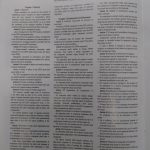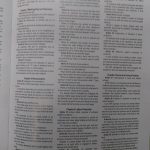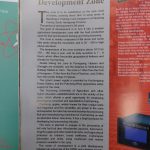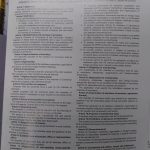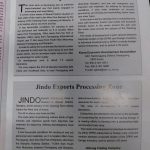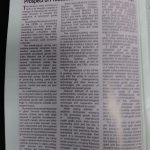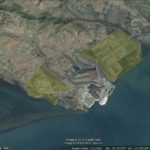By Benjamin Katzeff Silberstein
A couple of weeks ago, KCNA carried a report of Kim Jong-un’s oversight of a grand, general reconstruction plan for Sinuiju, North Korea’s most important hub for trade with China.
North Korea, it seems, expects that trade primarily with China will continue to grow and remain the country’s most important source of foreign currency revenue for the foreseeable future. This is something to keep in mind through the speculations about US and other western investments in North Korea in the event that sanctions are lifted and denuclearization (whatever version of it) comes through.
The plans for Sinuiju are also notable simply because Sinuiju is not Pyongyang. There has been quite a bit of work done in the past few years, under Kim Jong-un, at extending the renovations drive and infrastructure construction to smaller, provincial cities (mostly provincial capitals). One message seems to be that Kim Jong-un’s ambitions and promises of economic development aren’t just for the elite, but for the population as a whole.
It’s unclear how the plans that Rodong speaks of are related to the Sinuiju International Economic Zone. An issue of the quarterly North Korean magazine Foreign Trade in 2015 indicated that renovations of Sinuiju would focus on infrastructure renewal, but as the example of the bridge to nowhere shows (see below), it’s unclear what actual progress is being made in reality on this.
Some specific thoughts and annotation below (my emphasis, except on the leader’s names, that’s all standard KCNA):
Pyongyang, November 16 (KCNA) — Kim Jong Un, chairman of the Workers’ Party of Korea, chairman of the State Affairs Commission of the Democratic People’s Republic of Korea and supreme commander of the Korean People’s Army, examined and guided the master plan for Sinuiju City together with leading officials of the party, administration and design organs of North Phyongan Province.
Learning about the implementation of the behests of President Kim Il Sung and Chairman Kim Jong Il for the construction of Sinuiju City and examining in detail the master plan for the construction of Sinuiju City and a diorama of the future city, Supreme Leader Kim Jong Un set forth the tasks and ways of successfully sprucing up Sinuiju City to meet the demand of the present era.
“The present era” = likely, the era of a growing middle class with demands for consumption and entertainment, many of which make their money through the markets and semi-private business.
He said that it is necessary to form the center of Sinuiju City deep up to the southern Sinuiju area with the statues of
Kim Il Sung and Kim Jong Il at the center square of the city as the axis, arrange high-rise apartments and public buildings at provincial and city levels in its surroundings in a dimensional way, successfully arrange the blocks of high-rise and skyscraper apartment buildings along the main axis and arterial road of the city and the bank of the Amnok River in formative artistic way and build many parks within the dwelling area and thus turn the city into the one in the park.
This all sounds very expensive. Meanwhile, North Korea faces largely unfunded humanitarian needs, which could be met relatively cheaply. In fact, the equivalent of one-sixth of North Korea’s total luxury goods imports in 2017 would be enough.
Saying that it is necessary to build many modern and majestic architectures rich in national character in order to build the city befitting to a gateway city of the country, he called for successfully arranging the public buildings such as theatre, cinema, sports village, ice rink and sci-tech library and service facilities including hotel and department store in a rational way and to be of modern taste.
Books have been written about the concept of “rationality”, so I won’t go into what the use of that phrase means in this context. But it does sound like what Kim is talking about is simply making Sinuiiju “modern”, with all of what that entails. These days, there’s quite a bit of reporting and chatter around about how Pyongyang, and other North Korean cities, have undergone stark modernizations during Kim’s tenure. This is clearly true, but it’s worth remembering the reason why these things are news: the presence of “service facilities”, “department store[s]” and the like, things taken for granted in much of the world, is still not widely spread in North Korea outside of Pyongyang. (This is also true for Wi-fi.)
He also gave a direction of sprucing up the present industrial areas and remodeling the railway station of the city and Uiju Airport in a modern way.
Speaking of infrastructure: this is the only part of the article where infrastructure is mentioned. It is interesting and notable that despite the attention and grand plans for Sinuiju, the new bridge connecting the city to Dandong had still not been connected to North Korea’s road network as of mid-February this year, as far as I can tell from satellite imagery. This is the most recent date for which imagery is available.
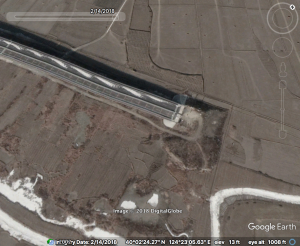
The end of the new bridge from Dandong, on the North Korean side. Photo: Google Earth.
Underlining the need to pay deep attention also to the creation of cultural environment including urban greening, he called for creating green belts near the city’s main road and around the industrial area to make sure that one citizen has 50 square meters of green tract of land, and for building city park, botanical garden and recreation ground in a cozy and peculiar manner to suit the specific conditions of the local city.
Again, that’s going to cost a lot of money, and not least, human effort. Citizens might be happy about green spaces, but they’ll be less so at having to go out and construct them through “voluntary” labor.
Noting that it is most important in urban construction to make sure that citizens don’t feel any inconvenience, he said that it is necessary to increase electricity production and make a maximum use of natural energy so as to round off the city electricity supply network system, perfect the heating system, put the water supply on an international standard and properly establish the system for purifying industrial waste water and sewage as the city has dense arrangement of residential quarters and industrial establishments.
Electricity and energy supply is one of the main achilles heels for the North Korean economy, and its industry is highly vulnerable to shortages in electricity supply. “Maximum use of natural energy” sounds like hydrogen power to me, which is North Korea’s most plentiful source of electricity. Aside from coal, that is, but given the export value of coal, its use for domestic electricity production comes with a high opportunity cost. In any case, the North Korean administration is clearly aware (and has been for decades) that energy is a big problem, and bringing it up in conjunction with a city plan inspection is likely a way of sending the message that the authorities are working on it. How exactly that is being done is less clear.
On the theme of energy in Sinuiju, it might be worth noting that the city is home to one of the country’s main oil refineries, the Ponghwa Chemical Factory, south of the city.
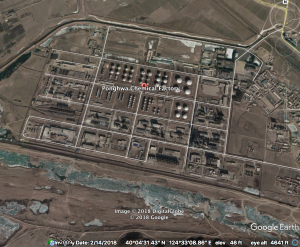
Ponghwa Chemical Factory, south of Sinuiju. Photo: Google Earth.
As I keep stressing all the time, the provincial party committees should pay special attention to the work of intensifying the provincial design organs and construction forces and put constant efforts on it and thus decisively raise the level of the building in the construction projects of local areas, he pointed out.
Calling for reviewing the master plan for Sinuiju City and the long-term goals for city construction in cooperation with powerful design organs of the country, remapping it out to be realistic and submitting it within a few months, he said that the Party Central Committee would discuss and decide on the plan after going through relevant procedures, and the construction of the border city would be conducted year by year and phase by phase with the state backing after setting the goals of 5-year plan.
Noting that the work of remodeling Sinuiju City for which President Kim Il Sung and Chairman Kim Jong Il gave instructions dozens of times is a very important task of carrying out their behests, he stressed the need to gain good fruition within a few years to come.
Article source:
Supreme Leader Kim Jong Un Guides Master Plan for Construction of Sinuiju
Political News Team
Rodong Sinmun
2018-11-16
[Updated 2018-12-6: I added a few details throughout the post, as well as satellite imagery.]



